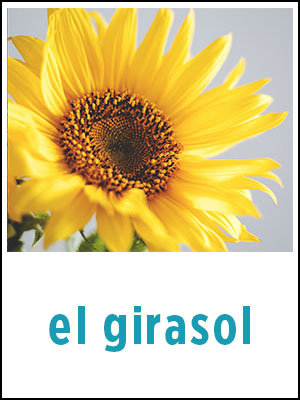Family Activity to Promote Bilingualism During Summer Break
Kids of all ages can't wait for summer. Family bonding and extended bilingual learning is something you can pursue when there is no school, and there is time to explore other interests and hobbies. Pressing flowers and leaves is a time-honored craft that our grandmothers and their grandmothers enjoyed. Generations of children in different cultures have delighted in preserving a bit of summer or fall, then using the pressed flowers and leaves in crafts.
Sample Flashcard for “sunflower” in Spanish
Help your child to learn the names of the flowers and leaves in their second language. Learning flower and leaf names is a great activity for extending your child's bilingual education through the summer months. You can even create flashcards using the dried flowers. Your handcrafted cards can supplement the Little Pim Flashcard set in your current curriculum. Not only will you advance your child's vocabulary in their second language, but you will also be adding to their botanical knowledge.
Research shows that children can lose many of the gains they made in reading, writing, math, and language acquisition over the summer months. Planning summer activities to keep your child learning will keep them on-track and ready to move forward when they return to school in the fall.
How to Press Flowers
The simplest way to press flowers is in between the leaves of a thick book. Any flat open-faced flower will work. Some flowers that press well are geraniums, pansies, oxalis, Queen Anne's Lace and phlox. These abound in the spring and summer months, in most areas of the United States and many other countries. Leaves press well too. Include leaves of common trees such as oak, maple, elm, and willow. For contrast, press the colorful leaves in the fall, as well.
1. Pluck dry, flat-faced flowers, to press. Remember, never remove flowers if there are only a few in that area. Choose flowers that are abundant, and don't take all of them. Make sure there are enough left so that the plant will be able to reproduce.
2. Spread the flowers out flat, on at least two layers of tissue paper. Cover with two or more layers of tissue, or white paper towel.
3. Place the paper, with the flowers inside, between the pages of a thick book. Make sure the flowers are not touching.
4. Close the book, and place it where it will remain undisturbed.
5. Check to see if the flowers have dried, in about two weeks. If the flowers are sticking to the tissue paper, they are not sufficiently dried. Close the book, and leave the flowers for another two weeks.
6. Use the flowers when they are sufficiently dried in your craft activities, home-made books, and flashcards. When flowers and leaves no longer stick to the paper, they are sufficiently dried.
To learn more about Little Pim's award-winning language learning program for kids ages 0-6, please visit our website or contact us during office hours. We hope you have a great summer with your little ones!


